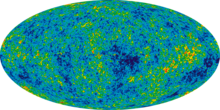Our website is made possible by displaying online advertisements to our visitors.
Please consider supporting us by disabling your ad blocker.
Hadron epoch
An editor has nominated this article for deletion. You are welcome to participate in the deletion discussion, which will decide whether or not to retain it. |
| Part of a series on |
| Physical cosmology |
|---|
 |
In physical cosmology, the hadronic epoch[1] started 20 microseconds after the Big Bang.[2] The temperature of the universe had fallen sufficiently to allow the quarks from the preceding quark epoch to bind together into hadrons. Initially, the temperature was high enough to allow the formation of hadron/anti-hadron pairs, which kept matter and anti-matter in thermal equilibrium. Following the annihilation of matter and antimatter, a nano-asymmetry of matter remains to the present day. Most of the hadrons and anti-hadrons were eliminated in annihilation reactions, leaving a small residue of hadrons. Upon elimination of anti-hadrons, the Universe was dominated by photons, neutrinos and electron-positron pairs. This period is referred to as the lepton epoch.
- ^ Cite error: The named reference
Refelski-2023was invoked but never defined (see the help page). - ^ Fromerth, M. J.; Kuznetsova, I.; Labun, L.; Letessier, J.; Rafelski, J. (2012). "From Quark-Gluon Universe to Neutrino Decoupling: 200 < T < 2MeV". Acta Physica Polonica B. 43 (12): 2261. arXiv:1211.4297. doi:10.5506/APhysPolB.43.2261. ISSN 0587-4254. S2CID 118448487.
Previous Page Next Page


